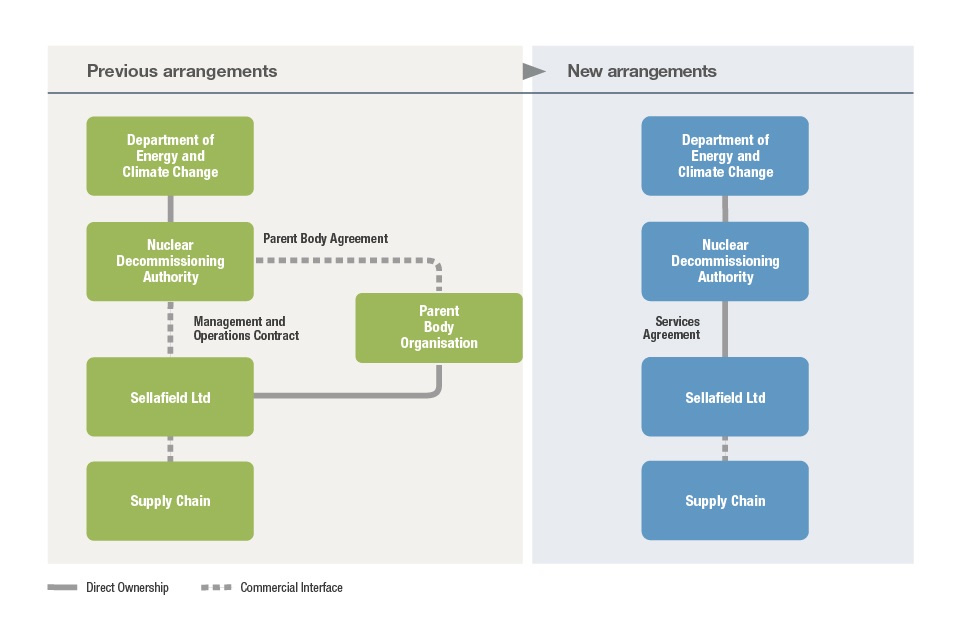Explained: the new model for managing Sellafield
Updated 1 April 2016
1. Introduction
The ownership and management arrangements at Sellafield Ltd, the organisation responsible for managing and operating Sellafield on behalf of the Nuclear Decommissioning Authority (NDA), have changed. The new arrangements have been developed to achieve accelerated and more efficient delivery of the mission.
On 1 April 2016 Sellafield Ltd became a wholly owned subsidiary of the NDA. The new model transfers ownership of Sellafield Ltd from private sector owner, Nuclear Management Partners, to the NDA, a non-departmental public body.
Sellafield Ltd continues to benefit from private sector expertise but that support comes from suppliers rather than a private sector owner. Sellafield Ltd uses best practice ways of introducing private sector support into public sector arrangements.
2. Background
In January 2015 it was announced that management arrangements at Sellafield would change. The decision taken by the NDA and endorsed by government followed a comprehensive review by the NDA into the current parent body organisation model. The NDA concluded that this model is not suitable for Sellafield. The site is not only the most complex of the NDA estate but across Europe. Its mission to retrieve nuclear waste from some of the world’s oldest nuclear facilities extends beyond 2120. The timescales for the delivery of key outcomes are in many cases decades away. Also, the sums of money involved are much greater than on other NDA sites.
The timescales, costs and complexities of the Sellafield mission mean Sellafield Ltd requires a model which enables better planning for uncertainty and long term outcomes.
The enormity of the Sellafield challenge is such that it demands a relentless focus on the long-term clean-up mission and improved performance. Although the previous model brought some progress, the pace of progress needed to accelerate and be delivered more efficiently.
3. New governance arrangements
NDA and Sellafield Ltd have jointly developed the new governance, management and operating arrangements. These arrangements aim to create an environment in which there is greater opportunity for achieving accelerated and efficient delivery of one of the world’s most challenging nuclear clean-up mission.
Reprocessing at Sellafield will come to an end by 2020 and the sole focus for activity will soon be high hazard reduction and decommissioning of nuclear facilities. This is a big change for Sellafield Ltd.
The success of both NDA and Sellafield Ltd depends upon the safe and efficient clean-up of the Sellafield site. As owner and subsidiary the two organisations can now align on the way in which that mission is delivered. The NDA and Sellafield Ltd will work together to fulfil their respective parts in delivering success at Sellafield and meeting the expectations of stakeholders.
Simple governance and management arrangements provide a clear line of sight from the Department of Energy and Climate Change (DECC) to the NDA and through to Sellafield Ltd.

Previous arrangements for governance of Sellafield Limited compared to the new arrangements post 1 April 2016
| Previous arrangements | New arrangements |
|---|---|
| Private sector ownership of Sellafield Ltd | Sellafield Ltd a subsidiary of the NDA |
| Sellafield Ltd chair appointed by Parent Body Organisation | NDA appoint the chair and up to 2 non-executive directors to the Sellafield Ltd Board |
| A Management and Operations Contract between the NDA and Sellafield Ltd | A Services Agreement between the NDA and Sellafield Ltd replaces the Management and Operations Contract |
| = complex structures putting a burden on Sellafield Ltd teams | = simple structures and less interface bureaucracy leading to alignment and greater focus on the mission |
4. Partnering with the private sector to improve performance
Under the change of model, Sellafield Ltd will engage the private sector through one or more partnerships to support improved performance.
Sellafield Ltd are developing a proposition for this Market Enhanced Model (MEM) for formal tender in the financial year 2016/17. This will build on the learning and good practices of other organisations already involved in collaborative arrangements within both the public and private sector.

